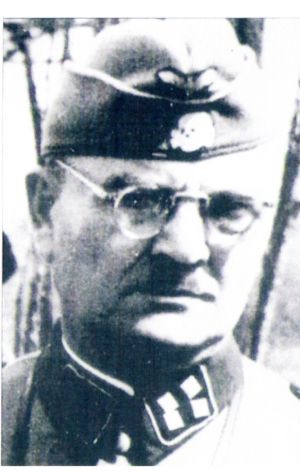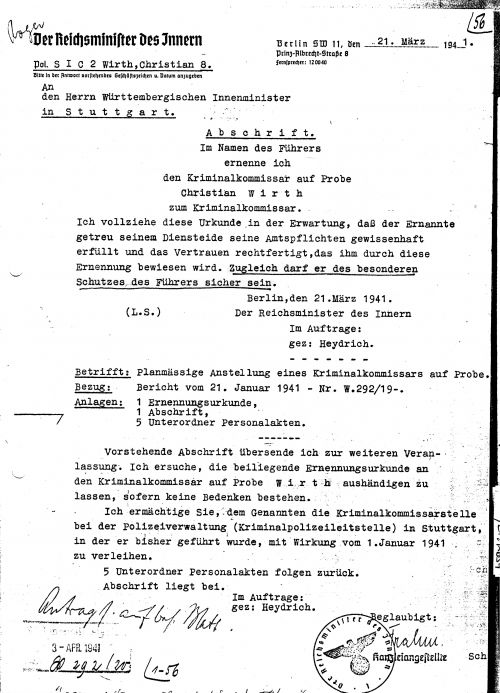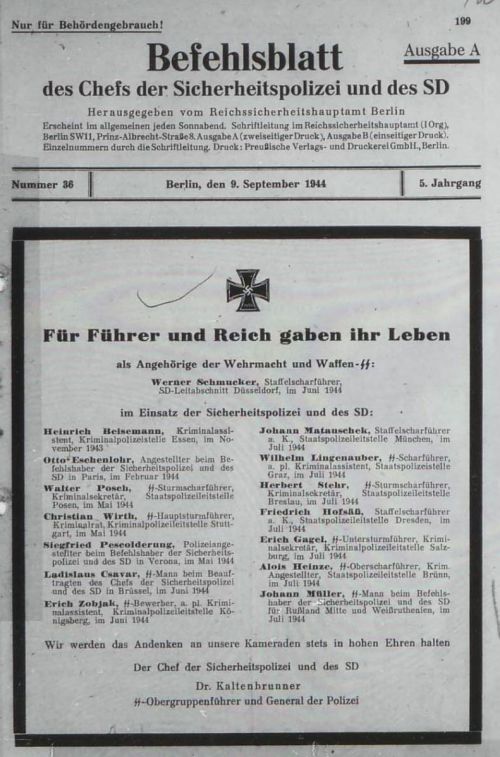Christian Wirth

Christian Wirth in Italy 1944
Christian Wirth was born on 24 November 1885 in Oberbalzheim, Württemberg, in south-west Germany. Following the completion of his educationhe was employed as an apprentice carpenter with the Bühlerbrother’s timber firm in Oberbalzheim. From 1905-1907 he served hismilitary duty with Grenadier Regiment 123 in Ulm, and after a short break, re-enlisted to serve another two years. After an honourable discharge from the army in 1910, Wirth joined the Württemberg State police as a uniformed constable, and in the same year married Maria Bantel, with whom he had two sons. In 1913, Wirth transferred to the Krimialpolizei (Kripo), the plain clothes detective squad.
In October 1914, he volunteered to serve in the army of Kaiser Wilhelm II and saw action on the Western Front in Flanders and northern France, in the Reserve Infantry Regiment 246 (Ulm). He received a field promotion to acting officer (Offizier Stellvertreter) and awarded several medals and decorations for bravery, including the Iron Cross I and II Class and the Gold Württemberg Military Service Medal. At the end of 1917, Wirth was transferred back to Stuttgart as an officer in the Military Police (Militärpoizei) guarding a supply depot for Reserve Infantry Regiment 119. During this duty he won high praise for defending the depot against the Spartakists, the forerunners of the Germn Communist Party.
Wirth rejoined the Kripo in 1919 and by 1923 was the head of Precinct II (Dienststelle II) on Büchsenstrasse in Stuttgart. He earned a reputation for solving difficult crimes that had defeated other officers, often by using brutal methods of interrogation. His ‘dedication and zealous methods,’ finally led to questions being asked about him in the Württemberg Regional Parliament (Landstag). In 1937, Wirth was the head or deputy head of all police and Party organizations in the Stuttgart area and was recruited by Reinhard Heydrich’s Security Service (Sicherheitsdienst – SD) as a ‘V-Mann,’ (Vertrauensmann), a confidential agent, spying and informing on his Party and police comrades. By 1939, Wirth had reached the rank of Kriminalinspektor, in charge of Kommisariat 5,a special detective squad for investigating serious crimes, including murder. Wirth then carried out special police duties in Vienna, and in Olmütz, Czechoslovakia.

Heydrich Letter - Wirth - Special protection of the Fuhrer
In the autumn 1939, Wirth was appointed to the T4 euthanasia programme and because of his now well-known reputation for administration and organization, assisted in setting up the bureaucracy. In mid-January he was among a group of high-ranking Nazi officials who witnessed the first test gassing of psychiatric patients in an abandoned prison in Brandenburg-an-der-Havel near Berlin. Among this group were Reichsleiter Philipp Bouhler, head of Hitler’s private Chancellery, Dr Karl Brandt, Hitler’s escorting physician (Begleitarzt), Dr Leonardo Conti, Secretary of State for Health, and SS-Oberführer Viktor Brack, chief of Head Office II (Hauptamt II) of Hitler’s private Chancellery. Brack was soon to be in charge of the daily running of the euthanasia operation. At the beginning of February 1940, Wirth arrived at the first T4 euthanasia institution established in Grafeneck castle, 60 kilometers south of Stuttgart, where he became head of administration and security. In May 1940, Wirth was appointed ‘roving inspector’ of the euthanasia institutions, to tighten-up discipline among the staff, improve security, and streamline the killing process and the ensuing paperwork. He spent much of his time in the euthanasia institution in Hartheim castle, near Linz in Upper Austria. It was here that he encountered Franz Stangl, the future commandant of the Aktion Reinhardt death camps at Sobibór and Treblinka. At Hartheim castle, Stangl was in charge of administration and security. His first meeting with Wirth made a profound impression on him, as he told Gitta Sereny during their series of interviews for her book ‘Into That Darkness’:
Wirth was a gross and florid man. My heart sank when I met him. He stayed at Hartheim for several days that time and often came back. Whenever he was there he addressed us daily at lunch. And here it was again this awful verbal crudity: when he spoke about the necessity for this euthanasia operation, he was not speaking in humane or scientific terms ... he laughed. He spoke of ‘doing away with useless mouth’s, and that sentimental slobber about such people made him puke’
Just before Christmas 1941, Wirth arrived in Bełżec and in the New Year began experimenting with various different methods of gassing in three primitive gas chambers, including in the early days a primitive gassing van. Among other methods tested were Zyklon B, using the exhaust from lorries and bottled carbon monoxide (CO) gas, the same method used in the euthanasia institutions. He finally decided on CO gas produced from a Russian tank engine. This method was then applied at the other two Aktion Reinhardt death camps Sobibór and Treblinka, together with the ‘conveyor-belt’ method of dealing with the victims. Wirth ran the Belzec death camp with a rod of iron, and at Belzec experimented until he perfected the killing process; he was feared by the staff, Germans and Ukrainians alike. After ensuring that Bełżec was operating effiiciently, Globocnik appointed Wirth on the 1 August 1942 to the post of ‘Inspekteur der SS-Sonderkommando Aktion Reinhardt,‘ and he was based at first in the Julius Schreck Kaserne, the headquarters of Aktion Reinhardt. At the end of the year, Wirth’s Inspectorate was moved to a building on the Old Airfield just outside Lublin and close to Lublin concentration camp (Majdanek).
From mid-August 1942, Wirth played a leading role in the re-organisation of Treblinka, including the construction of the new gas chambers, and thereafter visited the camp frequently. In September 1943, Wirth, Stangl and Globocnik were transferred to Trieste in northern Italy where Globocnik had been appointed the Higher SS and Police Leader for the Adriatic Coastal Region (Adriatisches Küstenland). Wirth was given command of three special units formed from former Aktion Reinhardt personnel, including many of the Ukrainian guards, most of whom had arrived in Trieste by the end of the year. Their task was rounding-up and deporting the remaining Italian Jews to Auschwitz-Birkenau, and confiscating their property. Later these units were switched to anti-partisan duty on the Istraian peninsula where they committed atrocities against the Yugoslav and Italian population.
Christian Wirth was killed by Yugoslav partisans of the First Battalion of the ‘Istrska’ (Istrian) Division on 26 May 1944 near Kozina, just outside Trieste. He was on his way to inspect one of his SS-units in Fiume on the other side of the peninsula. Wirth was buried with full military honours in the German Military Cemetery in Opicina near Trieste, but later, his remains and the remains of over 20,000 German troops killed in Italy and buried in numerous places, were exhumed and re-interred in a new and big German Military Cemetery at Costermano, on the south-eastern shore of Lake Garda, near Verona in northern Italy.

Christian Wirth's Death Notice (Bundesarchiv)
Sources
C.Webb & M. Chocholaty, The Treblinka Death Camp, Ibidem- Verlag, Stuttgart, 2014
Michael Tregenza- private correspondence
Christian Wirth – Personnel File – NARA, Washington DC
Photograph – Ghetto Fighters House, Israel
Tall Trees Archive -UK
Bundesarchiv
© Holocaust Historical Society 2018




